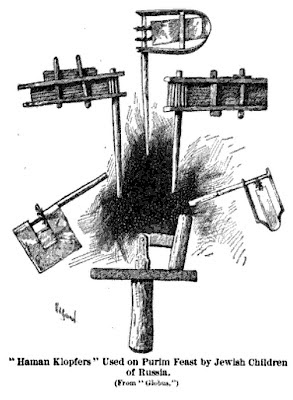Purim gragger image, PURIM: Jewish feast celebrated annually on the 14th, and in Shushan, Persia, also on the 15th, of Adar, in commemoration of the deliverance of the Persian Jews from the plot of Hainan to exterminate them, as recorded in the Book of Esther. According to that book the feast was instituted as a national one by Mordeeai and Esther. For a critical view of Purim see Estiikr. In the present article are treated only the various features of the feast as developed after its institution.
Aside from the much-mooted question whether Purim is of Jewish or of heathen origin, it is certain that, as it appears in the Book of Esther, the festival is altogether devoid of religious Non- spirit—an anomaly in Jewish religious Religious history. This is due to the worldly Character, spirit of the Book of Esther. The only religious allusions therein are the mention of fasting in iv. 16 and ix. 31, and perhaps the expression of confidence in the deliverance of Israel in iv. 14.
This secular character has on the whole been most prominent in this festival at all times. Like Hanukkah, it has never been universally considered a religious holy day, in spite of the fact that it is designated by the term "yom-tob" (Esth. ix. 19, 22). Accordingly business transactions and even manual labor are allowed on Purim. although in certain places restrictions have been imposed on work (Shulhan 'Aruk, Orah Hayvim, 696)
Nevertheless Purim lias been held in high esteem at all times and in all countries, some even maintaining that when all the prophetical and bagiographical works shall be forgotten the Hook of Esther will still be remembered, and, accordingly, the Feast of Purim will continue to be observed (Yer. Meg. i. 5a; Maimonides, "Yad," Megillah, iii. 18: comp. Sehudt, "Jl'idische MerkwOrdigkeiten," ii. 311). It is also claimed that Purim is as great as the day on which the Torah was given on Sinai (" Mordekai" on 1?. M. ix., end; conip. Lampronti, "Pabad Yizhak," ».t>. "Purim ''). In Italy the Jews, it seems, have even used the word "Purim" as a family name, which also proves the high esteem that the festival enj o y 8 a m nng them (Vogelstein and Hieger, "Gesch. der Juden in Rom," ii. 420; but comp. Steinschneider in "M o n a t s sehrift," 1903, p. 175).
The Book of Esther does not prescribe any religious service for Purim ; it enjoins only the annual celebration of the feast among the Jews on the 14th and 15th of Adar, c o m m a n ding that they should "make t h e m days of feasting and joy, and of sending portions one to another, and gifts to the poor." It seems, therefore, that the observance of Purim was at tirst merely of a convivial and social nature. Gradually it assumed religious features.
This Image (or other media file) is in the public domain because its copyright has expired. This applies to the United States, where Works published prior to 1978 were copyright protected for a maximum of 75 years. See Circular 1 "COPYRIGHT BASICS" PDF from the U.S. Copyright Office. Works published before 1923 in this case 1908, are now in the public domain.
TEXT and IMAGE CREDIT: The Jewish encyclopedia: a descriptive record of the history, religion, literature, and customs of the Jewish people from the earliest times to the present day, Volume 10. The Jewish Encyclopedia: A Descriptive Record of the History, Religion, Literature, and Customs of the Jewish People from the Earliest Times to the Present Day, Isidore Singer.
Editors: Isidore Singer, Cyrus Adler. Translated by: Isidore Singer. Publisher: Funk & Wagnalls Company, 1907. Original: from the University of Michigan. Digitized: Jan 6, 2011. Subjects, Religion › Judaism › General, History / Jewish, Jewish encyclopedia
Jews, Religion / Judaism / General.

No comments:
Post a Comment